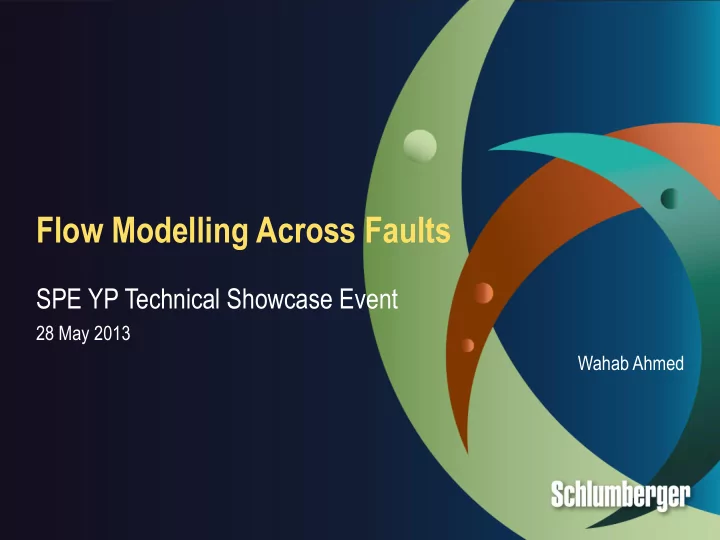

Flow Modelling Across Faults SPE YP Technical Showcase Event 28 May 2013 Wahab Ahmed
Agenda Faults-Introduction Fault Pattern Fault Zone Properties – Fault Permeability, Fault Thickness Fault Transmissibility Multiplier Calculation Fault Threshold Pressure – Constant Fault Threshold Pressure , Variable Fault Threshold Pressure Wrap-up – Conclusions , References 2
Fault Fault Fault is a fracture, fissure or joint along which there have been relative displacement Normal Faults Normal fault is one in which the hanging wall falls down relative to the foot wall due to tensional stress Reverse Faults Reverse fault is one in which the hanging wall moves up relative to the foot wall due to compression 3
Fault Pattern Parallel Fault or Bookshelf Model Graben or Rift Fault 4
North Sea Examples (After Glennie, 1990) Thistle Field (from Williams and Milne,1991) 5
Fault Zone 6
Factors affecting Fault zone seal Fault zone architecture Burial and Fault History and Juxtaposition of lithologies Local facies Pressure difference across fault Reservoir fluid type and saturation 7
Fault Zone Properties Fault Permeability -Vshale vs Permeability relationship , Explicit ,SGR & Vclay methods (Manzocchi ,Sperrevik methods) Fault Thickness - Estimation from Fault Displacement 8
Manzocchi Algorithm D=Fault Displacement in m SGR=Shale Gouge Ratio K=Permeability in mD 9
Sperrevik Algorithm Fault rock clay content (V f ) Maximum rock burial depth and (Z max ) Depth at time of deformation (Z f ) 10
Fault Thickness Displacement to Thickness Ratio Two Algorithms t f = D/66 (Hull, 1988) t f =D/170 (Walsh,1998) 11
Transmissibility Calculation Transmissibility in X direction 12
Fault Transmissibility Multiplier L 1 L 2 Trans 12 K 1 K 2 t f K f Trans 1-f Trans f-2 K 1 Trans fault K 2 L 1 L 2 Assumptions: Intersection Area=1 No Grid block dips 1D single phase flow 13
Field Case Study-Gulfaks 5 Injectors in the west flank 5 Producers in the eastern flank Injectors Control=Voidage replacement 14
Effect of Fault Permeability on Fault Transmissibility multiplier Fault Permeability=10mD Fault Permeability=1mD Fault Permeability=100mD 15
Effect of Fault Permeability on Flow Simulation 16
Fault Transmissibility multiplier (Manzocchi Vs Sperrevick Correlation) Sperrevik method for Fault Manzocchi Method for Fault Permeability from SGR Permeability from SGR 17
Manzocchi Vs Sperrevick Correlation effect on Flow Simulation 18
Effect of Fault Thickness on Fault Transmissibility multiplier Thickness to Thickness to Displacement Ratio=170 Displacement Ratio=66 Walsh Correlation Hull’s Correlation Thickness to Displacement Ratio=100 19
Effect of Fault Thickness on Flow Simulation 20
Fault Threshold Pressure Pressure=2550 psi Pressure=2500 psi Fault Threshold Pressure=100 psi No Flow Constant Fault Threshold Pressure - same value across the fault Variable Fault Threshold Pressure - different values for each cell connection across fault 21
Variable Fault Threshold Pressure Vshale Pressure (bar) 0 0 0.5 100 1 200 22
Transmissibility Multiplier for Fault Threshold Pressure Cases Fault Permeability=1 mD Fault Permeability=10 mD Fault Thickness to Displacement Ratio=66 23
Constant vs Variable Fault Threshold Pressure -1mD Case Early breakthrough for Variable Fault Threshold Pressure Case & gentle increase in water cut Difference in water cut is significant for lower values of Fault Permeability 24
Constant vs Variable Fault Threshold Pressure -10mD Case 25
Conclusion Fault zone Thickness and Permeability are important for flow modelling Fault Permeability affects are more significant between 1mD and 10 mD – Manzocchi algorithm gives low values of Fault Transmissibility multiplier as compare to Sperrevik Fault Displacement is used to predict fault thickness – Fault Transmissibility will be higher for higher value of Fault Displacement to Thickness ratio Fault Threshold pressure prevents the flow across fault interface – Early water breakthrough and gentle increase will be observed for variable fault threshold pressure case as compare to constant fault threshold pressure 26
References 1. Manzocchi , T. et al. (1999). “Fault transmissibility multipliers for flow simulation models”, Petroleum Geoscience, Vol. 5, pp. 53-63 2. Sperrevik , S. et al. (2002). “Empirical estimation of fault rock properties”, In: Hydrocarbon Seal Quantification (edited by Koestler, A.G and Hunsdale, R), NPF Special Publication 11, pp 109 -125. 3. Fisher, Q.J. et al. (Jan. 2006). ” Microstructural and Petrophysical Properties of Fault Rocks from the Snorre Field”, Rock Deformation Research Group, report 9454 4. Jonas Cordazzo , Clovis Raimundo Maliska , Antonio Fabio Carvalho da Silva Interblock Transmissibility Calculation Analysis for Petroleum Reservoir Simulation Department of Mechanical Engineering, Federal University of Santa Catarina . Brazil , pp 5 -7 5. Reservoir Structure Course material of IPE Heriot Watt University by Dr J Couple 27
Questions
Recommend
More recommend